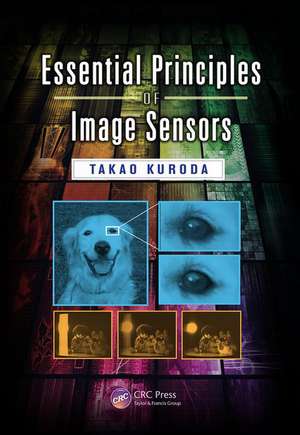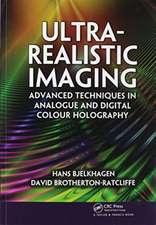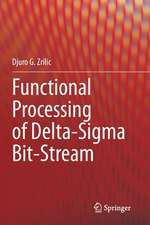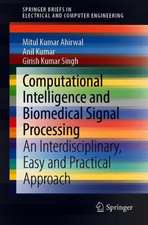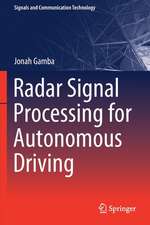Essential Principles of Image Sensors
Autor Takao Kurodaen Limba Engleză Paperback – 29 mar 2017
- Explains how image sensors convert optical image information into image signals
- Treats space, wavelength, and time as digitized built-in coordinate points in image sensors and systems
- Details the operational principles, pixel technology, and evolution of CCD, MOS, and CMOS sensors with updated technology
- Describes sampling theory, presenting unique figures demonstrating the importance of phase
- Explores causes for the decline of image information quality
| Toate formatele și edițiile | Preț | Express |
|---|---|---|
| Paperback (1) | 585.27 lei 6-8 săpt. | |
| CRC Press – 29 mar 2017 | 585.27 lei 6-8 săpt. | |
| Hardback (1) | 1220.46 lei 6-8 săpt. | |
| CRC Press – 12 aug 2014 | 1220.46 lei 6-8 săpt. |
Preț: 585.27 lei
Preț vechi: 688.56 lei
-15% Nou
Puncte Express: 878
Preț estimativ în valută:
111.99€ • 117.22$ • 93.21£
111.99€ • 117.22$ • 93.21£
Carte tipărită la comandă
Livrare economică 29 martie-12 aprilie
Preluare comenzi: 021 569.72.76
Specificații
ISBN-13: 9781138074170
ISBN-10: 1138074179
Pagini: 192
Ilustrații: 17; 5 Tables, black and white; 180 Illustrations, black and white
Dimensiuni: 178 x 254 mm
Greutate: 0.45 kg
Ediția:1
Editura: CRC Press
Colecția CRC Press
ISBN-10: 1138074179
Pagini: 192
Ilustrații: 17; 5 Tables, black and white; 180 Illustrations, black and white
Dimensiuni: 178 x 254 mm
Greutate: 0.45 kg
Ediția:1
Editura: CRC Press
Colecția CRC Press
Cuprins
Task of Imaging and Role of Image Sensors. Device Elements and Circuits for Image Sensors. Major Types of Noise in Image Sensors. Integration Period and Scanning Mode. Types of Image Sensors. Impacts of Digitization by Built-In Coordinate Points on Image Information Quality. Technologies to Improve Image Information Quality. Imaging Systems.
Recenzii
"... covers the basic principles of image sensors from semiconductor devices to sensor physics to image processing fundamentals. Each new concept is presented in a clear manner and the text is elegant, with the author giving essential details and generous insights without adding excessive details. I highly recommend this publication to engineers and applied physicists. Although the subject matter is very technical, it would also be of interest to graduate students."
—Professor Christian Brosseau, Université de Bretagne Occidentale, Brest, France, from Optics & Photonics News, February 2015
"The main strength of this book is the breadth of the covered material— from basic semiconductor device and sensor physics to specifics of various types of image sensors, image processing fundamentals, and imaging systems performance. Thus, this book is useful to anyone who wishes to learn the basics of various aspects of image sensors."
—Maxim Ershov, Silicon Frontline Technology, Campbell, California, USA
"… unmatched by any other book in describing techniques for building competitive CMOS image sensors. … fundamentally grounded in sampling theory."
—Tobi Delbruck, Institute of Neuroinformatics, University of Zurich and ETH Zurich, Switzerland
"… a good general resource for digital imaging technologists. … The author is clearly an expert in the field and has assembled a practical review of this technology."
—Ray Fontaine, Chipworks, Inc., Ottawa, Ontario, Canada
—Professor Christian Brosseau, Université de Bretagne Occidentale, Brest, France, from Optics & Photonics News, February 2015
"The main strength of this book is the breadth of the covered material— from basic semiconductor device and sensor physics to specifics of various types of image sensors, image processing fundamentals, and imaging systems performance. Thus, this book is useful to anyone who wishes to learn the basics of various aspects of image sensors."
—Maxim Ershov, Silicon Frontline Technology, Campbell, California, USA
"… unmatched by any other book in describing techniques for building competitive CMOS image sensors. … fundamentally grounded in sampling theory."
—Tobi Delbruck, Institute of Neuroinformatics, University of Zurich and ETH Zurich, Switzerland
"… a good general resource for digital imaging technologists. … The author is clearly an expert in the field and has assembled a practical review of this technology."
—Ray Fontaine, Chipworks, Inc., Ottawa, Ontario, Canada
Notă biografică
Takao Kuroda earned his bachelor, masters, and doctorate degrees from Osaka University, Japan. Throughout his illustrious career, he has held positions in the Panasonic Corporation’s Electronics Laboratory, Kyoto Research Laboratory, Elemental Technology Development Group, and Image Sensor Business Unit. He initially retired from Panasonic in December 2005, but at the company’s request, he accepted an advisory role to establish a technology strategy. In 2011, he retired completely to write the Japanese version of Essential Principles of Image Sensors. An ITE fellow, Dr. Kuroda holds 70 Japanese and 15 US patents. His research has contributed to numerous technological advancements around the world.
Descriere
This must-have book provides a succinct introduction to the systemization, noise sources, and signal processes of image sensor technology, discussing image information and its four factors: space, light intensity, wavelength, and time. Insightfully illustrated, the text explains how image sensors convert optical image information into image signals, as well as details the operational principles, pixel technology, and evolution of CCD, MOS, and CMOS sensors. It also describes sampling theory and explores causes for the decline of image information quality.
